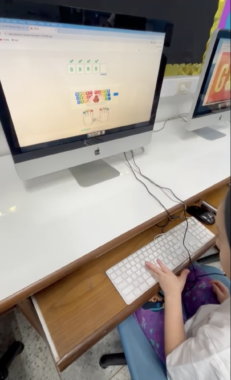Unlocking new occupational therapy skills by chance
A lucky discovery reminds us not to underestimate our daughter's potential
Written by |

When we discovered our daughter, Rylae-Ann, was born with the rare disease aromatic l-amino acid decarboxylase (AADC) deficiency, our lives underwent a complete transformation. Every decision we made, from the smallest daily task to the larger choices about her care, was centered around helping her progress. We adapted to what my wife, Judy, aptly referred to as the “caregiver lifestyle,” one that prioritized our daughter’s needs at every turn.
This lifestyle, while overwhelming at times, became our routine as we embraced each new challenge. With every adjustment, we focused on identifying key areas of improvement while eliminating goals that weren’t realistic. Many of our early dreams and expectations had to take a detour, but that didn’t mean they were lost. They were reimagined.
Among the new realities we quickly adopted was the importance of occupational therapy (OT). It became a lifeline, offering us a way to help Rylae-Ann develop the physical, sensory, and cognitive skills necessary for independence. Fostering independence is our ultimate goal for Rylae-Ann. We dream of a future where our daughter can navigate life with as much autonomy as possible.
Incorporating OT into our daily lives became second nature. For example, feeding time evolved into a practice session for fine motor skills, while reading a book or engaging with a video became an opportunity to work on gross motor coordination. The more we could blend OT strategies into routine tasks, the more progress we saw in Rylae-Ann’s abilities.
One area that’s continued to be challenging for her is writing. We’d all but removed iPads from her daily activities, focusing instead on traditional writing drills. But as it turns out, an unexpected opportunity would present itself during a simple homework assignment that we’d almost dismissed.
An accidental discovery

After correctly typing the letter “B” on the keyboard, Rylae-Ann works on using her thumb to press the space bar. (Courtesy of Richard E. Poulin III)
It was during that technology class homework assignment that Judy and I stumbled upon a discovery that would transform how we approach Rylae-Ann’s learning. The app she was assigned to use, TypingClub, was designed to teach basic typing skills. At first glance, we saw it as a fun activity, but not something that would significantly contribute to her development. After all, we’d been focused on improving her handwriting.
But as we watched, something extraordinary happened. The app, filled with bright animations and responsive sounds, captured Rylae-Ann’s attention in ways we hadn’t anticipated. The instructions on the screen prompted her to use specific fingers to press the corresponding letters. She carefully maneuvered her index finger to tap the “B” key, followed by an impressive stretch of her thumb to tap the space bar — just as the app instructed.
Her tongue stuck out in concentration, and her fingers curled in, struggling to maintain the coordination needed. Yet there it was: Our daughter was typing. And with every keystroke, we saw more than just letters appearing on the screen. Rylae-Ann was improving her finger dexterity and coordination, areas we’d worked so hard to develop through OT. Her technology teacher proudly sends photos documenting her progress.
A new path to progress
This simple app did more than teach our daughter typing skills; it opened our eyes to her potential in ways we hadn’t expected. While we’d spent years working on forming letters with a pencil, here she was, writing through typing. The increased dexterity we observed from this digital practice wasn’t just benefiting her communication skills; it was a skill itself, one that could support her in all kinds of daily tasks.
For Judy and me, this experience was a reminder not to underestimate our daughter’s abilities. We’d unintentionally set limitations by focusing too narrowly on what we’d thought was best. The novelty of this typing app, something we’d considered outside the scope of her therapy, proved to be the very thing she needed to make new strides.
We’ll continue to guide Rylae-Ann through traditional writing drills, but with a renewed perspective. This surprising discovery taught us that we must remain open to new methods and experiences that may help her progress in ways we hadn’t imagined. As parents and caregivers, it’s easy to set boundaries based on assumptions, but we’ve learned that breakthroughs often come when we least expect them.
Through this journey, we’ve come to realize that every challenge and every new activity carries the potential for growth. Rylae-Ann’s journey continues, and with it, we’re committed to supporting her in ways that tap into her curiosity, potential, and drive. Whether through typing apps or future surprises, we’ll be there to guide her every step of the way.
Note: AADC News is strictly a news and information website about the disease. It does not provide medical advice, diagnosis, or treatment. This content is not intended to be a substitute for professional medical advice, diagnosis, or treatment. Always seek the advice of your physician or other qualified health provider with any questions you may have regarding a medical condition. Never disregard professional medical advice or delay in seeking it because of something you have read on this website. The opinions expressed in this column are not those of AADC News or its parent company, Bionews, and are intended to spark discussion about issues pertaining to aromatic l-amino acid decarboxylase deficiency.







Leave a comment
Fill in the required fields to post. Your email address will not be published.